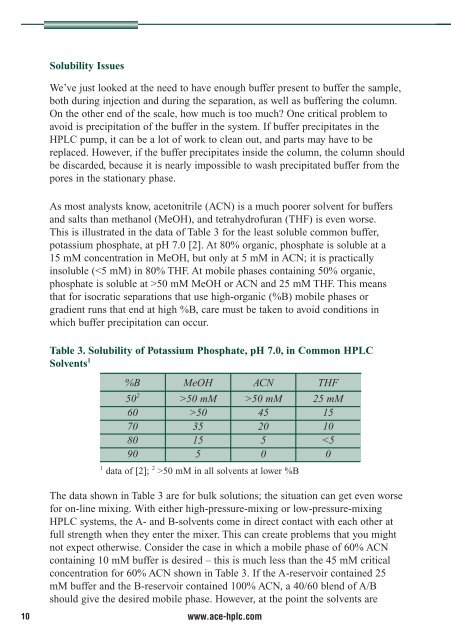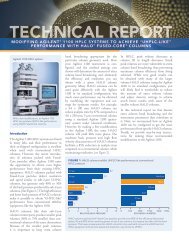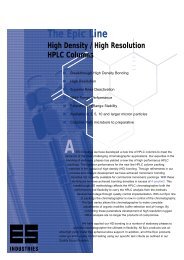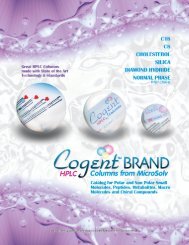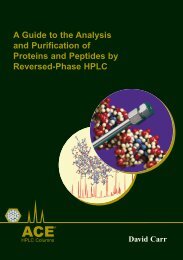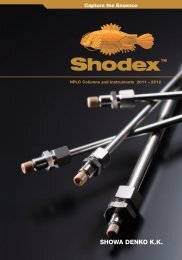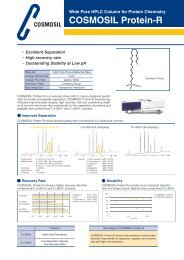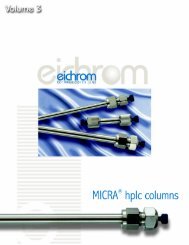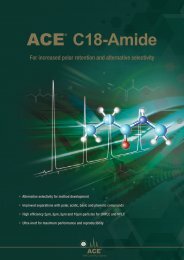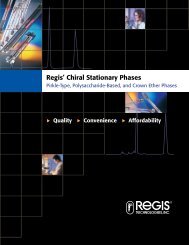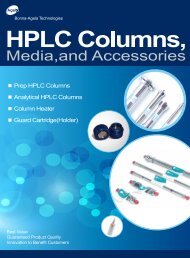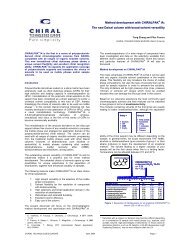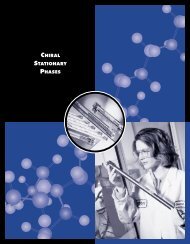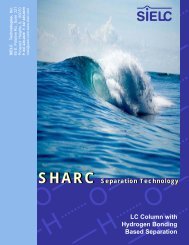A Guide to HPLC & LC-MS Buffer Selection - by John W ... - Hplc.eu
A Guide to HPLC & LC-MS Buffer Selection - by John W ... - Hplc.eu
A Guide to HPLC & LC-MS Buffer Selection - by John W ... - Hplc.eu
You also want an ePaper? Increase the reach of your titles
YUMPU automatically turns print PDFs into web optimized ePapers that Google loves.
Solubility Issues<br />
We’ve just looked at the need <strong>to</strong> have enough buffer present <strong>to</strong> buffer the sample,<br />
both during injection and during the separation, as well as buffering the column.<br />
On the other end of the scale, how much is <strong>to</strong>o much One critical problem <strong>to</strong><br />
avoid is precipitation of the buffer in the system. If buffer precipitates in the<br />
<strong>HP<strong>LC</strong></strong> pump, it can be a lot of work <strong>to</strong> clean out, and parts may have <strong>to</strong> be<br />
replaced. However, if the buffer precipitates inside the column, the column should<br />
be discarded, because it is nearly impossible <strong>to</strong> wash precipitated buffer from the<br />
pores in the stationary phase.<br />
As most analysts know, ace<strong>to</strong>nitrile (ACN) is a much poorer solvent for buffers<br />
and salts than methanol (MeOH), and tetrahydrofuran (THF) is even worse.<br />
This is illustrated in the data of Table 3 for the least soluble common buffer,<br />
potassium phosphate, at pH 7.0 [2]. At 80% organic, phosphate is soluble at a<br />
15 mM concentration in MeOH, but only at 5 mM in ACN; it is practically<br />
insoluble (50 mM MeOH or ACN and 25 mM THF. This means<br />
that for isocratic separations that use high-organic (%B) mobile phases or<br />
gradient runs that end at high %B, care must be taken <strong>to</strong> avoid conditions in<br />
which buffer precipitation can occur.<br />
Table 3. Solubility of Potassium Phosphate, pH 7.0, in Common <strong>HP<strong>LC</strong></strong><br />
Solvents 1<br />
%B MeOH ACN THF<br />
50 2 >50 mM >50 mM 25 mM<br />
60 >50 45 15<br />
70 35 20 10<br />
80 15 5 50 mM in all solvents at lower %B<br />
The data shown in Table 3 are for bulk solutions; the situation can get even worse<br />
for on-line mixing. With either high-pressure-mixing or low-pressure-mixing<br />
<strong>HP<strong>LC</strong></strong> systems, the A- and B-solvents come in direct contact with each other at<br />
full strength when they enter the mixer. This can create problems that you might<br />
not expect otherwise. Consider the case in which a mobile phase of 60% ACN<br />
containing 10 mM buffer is desired – this is much less than the 45 mM critical<br />
concentration for 60% ACN shown in Table 3. If the A-reservoir contained 25<br />
mM buffer and the B-reservoir contained 100% ACN, a 40/60 blend of A/B<br />
should give the desired mobile phase. However, at the point the solvents are<br />
10 www.ace-hplc.com


